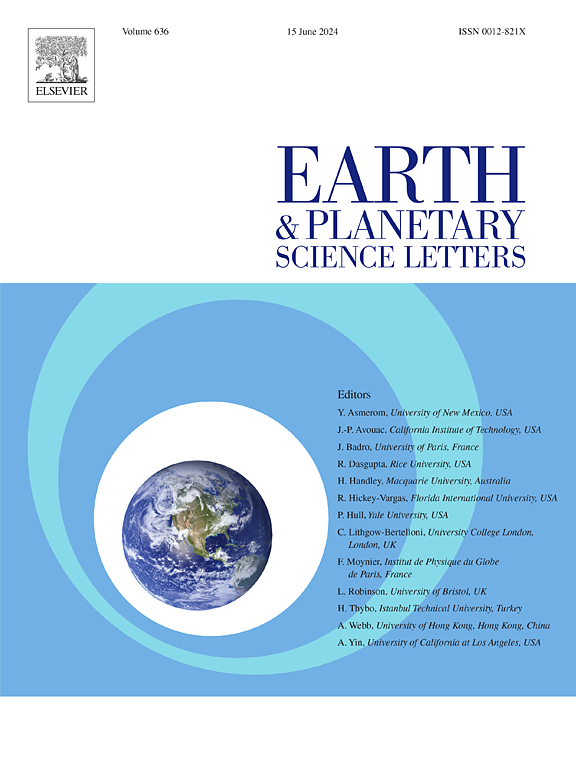Novel apatite provenance analysis reveals erosion of moraines as primary sediment source during glacial retreat
IF 4.8
1区 地球科学
Q1 GEOCHEMISTRY & GEOPHYSICS
引用次数: 0
Abstract
Climate change-driven glacial retreat is transforming alpine landscapes at unprecedented rates. As ice retreats, newly exposed valley walls and moraine sediment become vulnerable to hillslope and fluvial erosion that in turn can significantly increase fluxes downstream. These increases have important implications for water quality and storage, presenting risks to biodiversity, ecosystem stability, and human inhabitants. However, the mechanisms driving these increases remain unclear, with both enhanced subglacial bedrock erosion and the remobilisation of glacial sediments hypothesised. Resolving this uncertainty requires the ability to trace the exact sediment source within a catchment. Recent advances in apatite analysis using LA-ICP-MS techniques enable the simultaneous collection of thermochronometric, geochronometric, and chemical data from individual detrital grains. This now allows us to trace sediment sources across a glaciated catchment based on lithology and source-rock elevation. In this study, samples were collected across the Bugaboo Glacier catchment, British Columbia, Canada, where ice retreat has exceeded 2 km in the last century. Detrital samples were collected from the outwash river and two moraine locations, coupled with bedrock samples from varying elevations. Bedrock samples encompass the catchment’s two principal lithologies, a Cretaceous granitic intrusion, and Neoproterozoic metasediments. Thermochronometric dates show a positive relationship with elevation, while geochronometric dates and trace chemistry data help highlight key differences between lithologies. Detrital mixture models and multi-dimensional scaling suggest moraine samples are composed of sediment derived from a wide range of elevations within the catchment, while the sediments of the modern outwash river appear to be derived entirely from erosion of the moraines, left exposed by retreating ice. These findings suggest that increased sediment flux during glacial retreat is primarily driven by the remobilization of unconsolidated moraine materials, rather than enhanced bedrock erosion. Furthermore, this study demonstrates the effectiveness of multi-method detrital apatite analysis as a powerful provenance tool in studying sediment dynamics.
新的磷灰石物源分析表明冰碛侵蚀是冰川退缩过程中主要的沉积物来源
气候变化导致的冰川退缩正以前所未有的速度改变着高山景观。随着冰的退缩,新暴露的山谷壁和冰碛沉积物变得容易受到山坡和河流的侵蚀,这反过来又可以显著增加下游的通量。这些增加对水质和储水具有重要影响,对生物多样性、生态系统稳定性和人类居民构成风险。然而,驱动这些增加的机制仍然不清楚,冰下基岩侵蚀和冰川沉积物的重新活化都是假设的。要解决这种不确定性,就需要有能力追踪集水区内沉积物的确切来源。利用LA-ICP-MS技术进行磷灰石分析的最新进展可以同时收集来自单个碎屑颗粒的热时学、地时学和化学数据。现在,我们可以根据岩性和源岩高度追踪冰川流域的沉积物来源。在这项研究中,样本是在加拿大不列颠哥伦比亚省的布格布冰川集水区收集的,在上个世纪,那里的冰退缩超过了2公里。从外冲河和两个冰碛地点收集了碎屑样本,以及来自不同海拔的基岩样本。基岩样品包含了流域的两种主要岩性,白垩纪花岗岩侵入物和新元古代的变质沉积岩。热年代学数据显示与海拔高度呈正相关,而地质年代学数据和微量化学数据有助于突出岩性之间的关键差异。碎屑混合模型和多维尺度表明,冰碛样品是由来自集水区内广泛海拔的沉积物组成的,而现代外冲河的沉积物似乎完全来自冰碛的侵蚀,冰消退后暴露在外。这些发现表明,冰川退缩期间泥沙通量的增加主要是由未固结冰碛物质的再活化而不是基岩侵蚀的增强所驱动的。此外,该研究还证明了多方法碎屑磷灰石分析作为研究沉积物动力学的有力物源工具的有效性。
本文章由计算机程序翻译,如有差异,请以英文原文为准。
求助全文
约1分钟内获得全文
求助全文
来源期刊

Earth and Planetary Science Letters
地学-地球化学与地球物理
CiteScore
10.30
自引率
5.70%
发文量
475
审稿时长
2.8 months
期刊介绍:
Earth and Planetary Science Letters (EPSL) is a leading journal for researchers across the entire Earth and planetary sciences community. It publishes concise, exciting, high-impact articles ("Letters") of broad interest. Its focus is on physical and chemical processes, the evolution and general properties of the Earth and planets - from their deep interiors to their atmospheres. EPSL also includes a Frontiers section, featuring invited high-profile synthesis articles by leading experts on timely topics to bring cutting-edge research to the wider community.
 求助内容:
求助内容: 应助结果提醒方式:
应助结果提醒方式:


